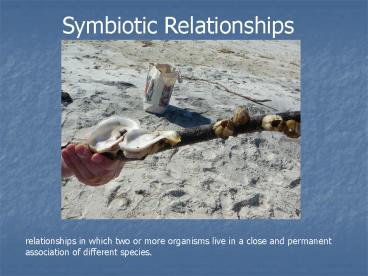Symbiotic Relationships - PowerPoint PPT Presentation
1 / 26
Title:
Symbiotic Relationships
Description:
Do hermit crabs prefer a particular kind of shelter (shells or not) ... Hermit crabs were placed in a Y maze during the chemical stimulus method. ... – PowerPoint PPT presentation
Number of Views:97
Avg rating:3.0/5.0
Title: Symbiotic Relationships
1
Symbiotic Relationships
relationships in which two or more organisms live
in a close and permanent association of different
species.
2
Three main types of symbiotic relationships
- commensalisms- one species benefits and the other
species is neither harmed nor benefited - Example barnacles on a whale
http//www.cbu.edu/seisen/ExamplesOfCommensalism_
files/image002.jpg
3
- mutualism- both species benefit
- Example Lichen on the trunk of a mangrove tree
http//members.optusnet.com.au/janewest000/Mangro
ve/images/lichen1.jpg
4
parasitism- one organism derives benefit at the
expense of the other Example guinea worms and
humans
http//www.neatorama.com/2006/08/21/six-horrifying
-parasites/
5
Question
- Name the 3 types of symbiotic relationships
6
Question
- Can you give other examples of symbiotic
relationships?
7
Hermit Crabs
http//myanimalblog.files.wordpress.com/2008/03/he
rmit-crab-cove-b1.gif
8
Classification
- phylum arthropoda,
- subphylum crustacean (marine hermit crabs)
- class Melacostraca
- order decapoda
9
Question
- What kingdom are hermit crabs in?
10
Answer
- Animalia
11
Hermit crabs have a symbiotic relationship with
discarded gastropod shells
12
Parts of a Hermit Crab
- Five pair of legs including a pair of claws
- The large claw is used for defense, such as
blocking the opening from predators and
shredding. - The small claw is used for eating.
- The second and third pair of legs is used for
walking. - The last pair of legs is used for holding the
crab in the shell.
13
www.thecrabbagepatch.com/crabanatomy.html
14
http//www.enchantedlearning.com/subjects/inverteb
rates/crustacean/label/hermitcrab/labelanswers.GIF
15
- Hermit crabs primarily live in the wild, but are
also very popular as pets. - Most are marine
- Typically live in the intertidal zone
Horn Island, Barrier Island Gulf of Mexico
16
Shell Facts
- they live in gastropod shells to protect
themselves from predators - they are scavengers
- shells are considered limiting resources
- When shells are damaged or do not fit
appropriately hermit crabs do not have adequate
protection and feeding and mating behavior
suffers. They change shells
17
Do hermit crabs prefer a particular kind of
shelter (shells or not)? In a study completed
by L.J. Rodrigues et al (2000), females were
significantly larger than male hermit crabs in
shells. More males where found in shells than in
tubes
18
- two methods to determine shell choice
- First, was a visual preference in which a
gastropod shell was placed next to a tube in the
center of a plastic container. - The second method was a chemical preference using
chemicals extracted from snails and mixed with
unfiltered seawater. The mixture consisted of
.1mL of unfiltered seawater to 0.1g of snail
tissue. Hermit crabs were placed in a Y maze
during the chemical stimulus method. Crabs who
were originally found in shells preferred shells
in the visual
19
Question
- Why do hermit crabs change shells?
20
Question
- Can you name other types of crabs?
21
Name that Crab
22
Not true crabs
23
(No Transcript)
24
(No Transcript)
25
(No Transcript)
26
References Mesce, K. (1982). Hermit crab goes
house-hunting. Science News, 121(10) p. 153 1/5
p. Rodrigues, L. J., Dunham, D. W., Coates, K.
A. (2000). Shelter preferences in the endemic
Bermudian hermit crab, calcinus verrilli
(rathbun, 1901) (decapoda,anomura)1).
Crustaceana, 73 (6) p. 737- 750. Spight, T. M.
(1977). Availability and use of shells by
intertidal hermit crabs. Biology McKenzie, N.
(1999). coenobita perlatus (Online), Animal
Diversity Web. Accessed November 29, 2008 at
http//animaldiversity.ummz.umich.edu/site/account
s/information/Coenobita_peratus.html































